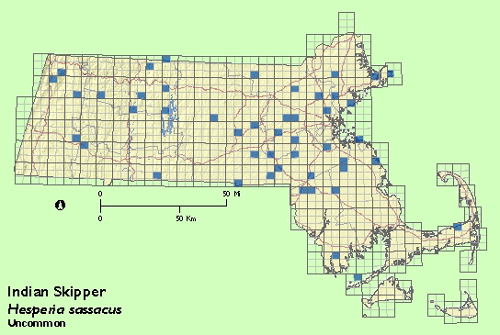Butterfly Atlas
Find a Butterfly
Indian Skipper
Hesperia sassacus
Named
Harris, 1862

Identification
This species is most likely to be confused with Long Dash (Polites mystic). Both are medium-sized, yellow-orange skippers with black wing borders above and a crescent-shaped band of pale yellow marks (often vague or scattered in sassacus) on the hindwing below. The Indian Skipper must be distinguished from the Long Dash by the offset fragment of the black border on the outer edge of the forewing above near the tip. In contrast, the corresponding area of the Long Dash forms a solid, continuous border. Late May records in Massachusetts are likely this species although both Indian Skipper and Long Dash are flying throughout June.
Distribution
Southeastern Manitoba and Minnesota east to Maine; southward from northern Indiana and Ohio through most of Pennsylvania and New Jersey and in the Appalachians through the Virginias. Opler and Krizek (1984) show it throughout the New England region excepting southeastern Massachusetts, the Cape, and Islands.
Status in Massachusetts
Scudder (1889) termed it rare in northern New England (four stations cited) while mentioning a dozen locations in the southern three states. Generally uncommon statewide, Indian Skipper was located across the state from the northwestern corner to Cape Ann and southward to Buzzards Bay and the Elizabeth Islands. There was, however, a relative paucity of records, 45 statewide during the Atlas period, and an apparent absence of this species in large portions of southeastern Massachusetts, including Cape Cod. Interestingly, Scudder (1889) cites a record by Sanborn for Cape Cod. Maximum: 6, Foxboro (Norfolk Co.), 29 May 1994.

Flight Period in Massachusetts
One flight: late May to late June. Extreme dates: 20 May 1986, Medford (Middlesex Co.), D. Schweitzer and 28 June1988, Hampden Hampden Co.), P. Jaques.
Larval Food Plants
A variety of grasses including Little Bluestem (Schizachyrium scoparius), Red Fescue (Festuca rubra), panic grasses (Panicum, spp), and Crabgrass (Digitaria sanguinalis).
Adult Food sources
Found nectaring on eight species of flowering plants including Blackberry, Wild Geranium, Daisy Fleabane, and Dogwood.

Habitat
Open areas, often with some shrubby growth, such as old fields, abandoned pastures, forest clearings, and powerline cuts.
Life Cycle
EGG: Greenish white to white; dome-shaped and smooth. OVIPOSITION: According to Scudder (1889) females begin to lay eggs around the 10th of June and these hatch out within two weeks. LARVA: Olive green with a dark head. CHRYSALIS: Brown with a whitish bloom. OVERWINTERING STAGE: Larvae PUPATION: pupating in early spring. Adults may be observed flying low across open meadows and old fields visiting various flowers for nectar.
Account Author
Richard K. Walton



